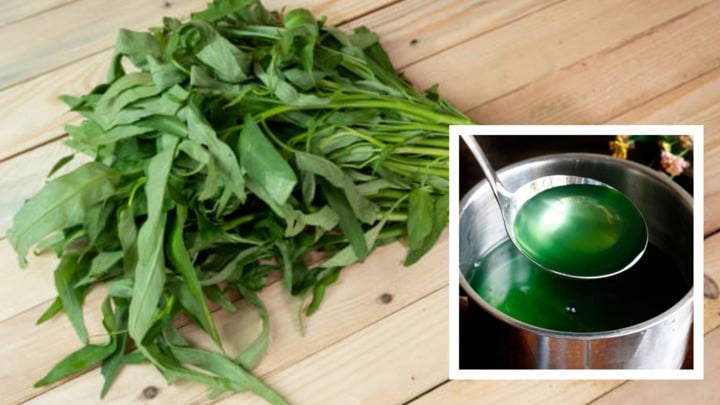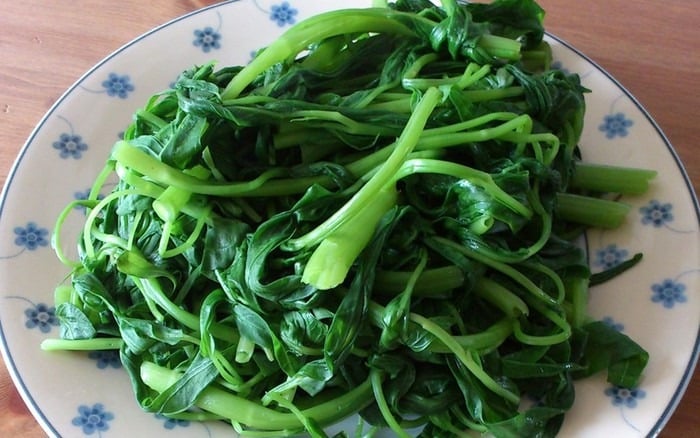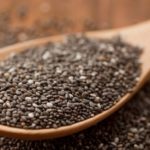Water Spinach: A Nutritional Powerhouse with a Unique Cooking Quirk
Water spinach, a humble herbaceous plant that typically creeps over water or muddy soil, is an important source of nutrients. It boasts an impressive nutritional profile, including vitamins A, B, and C, as well as calcium, phosphorus, and especially iron.
This versatile vegetable can be prepared in a variety of ways, such as boiling, stir-frying, salads, or soups, and it frequently makes an appearance on the daily dinner tables of many families. However, some people are concerned about the dark green color of the boiling water, and they are unsure if the vegetable is safe to consume.
Why Does Boiled Water Spinach Turn Dark Green?
According to medical expert Dr. Dang Ngoc Hung, from the Institute of Nutrition and Dietetics, the dark green color of the boiling water does not indicate that the vegetable is contaminated with chemicals. Water spinach contains high levels of chlorophyll, a green pigment that can interact with alkaline substances such as calcium and magnesium in the boiling water, resulting in dark green compounds.
Chlorophyll, with its Mg2+ core, has the ability to react with metal ions like AI3+, Cu, and Pb… to form darker-colored complexes. When water spinach is boiled in an aluminum or stainless steel pot, which contains ions like AI3+ and Cu, leaving the vegetable in the pot for an extended period can cause a reaction between the chlorophyll and the metal, resulting in a deep green color.
Additionally, when chlorophyll interacts with acids, it can turn slightly yellow to reddish. This explains why adding lime or dipping sour fruits into the water spinach broth turns the water clear or slightly yellow.

The dark green color of the boiling water does not indicate the presence of chemicals.
Adding a pinch of salt to the pot before boiling the vegetable will enhance its flavor, preserve its vitamins and nutrients, and ensure it retains its desired vibrant green color.
However, caution must be exercised when adding salt. Too much or too little salt can affect the taste and nutritional value of the dish, making it less appealing.
The perfect ratio of salt to water is 1 teaspoon of salt per ½ liter of water.
The Health Benefits of Water Spinach
Water spinach, a familiar ingredient in many households, is often chosen to be included in daily meals. The Vinmec International General Hospital’s website highlights some of the health benefits associated with consuming water spinach:
Anemia Treatment: Water spinach is rich in iron and can help treat anemia and provide iron for pregnant women.
Cardiovascular Health: Vitamins A, C, and beta-carotene in water spinach help reduce total cholesterol and the risk of atherosclerosis, thereby lowering the chances of heart attacks and strokes. Additionally, the magnesium in the vegetable helps lower blood pressure and protect cardiovascular health.

Water spinach is a familiar and popular choice for daily meals.
Cancer Prevention: Water spinach provides antioxidants that help prevent factors that cause cancer, such as colorectal, stomach, and breast cancer.
Treatment for Jaundice and Liver Problems: Extracts from water spinach can protect the liver from chemical damage.
Eye Health: Water spinach contains high levels of vitamin A and lutein, which help protect the eyes and prevent related issues like cataracts.
Anti-Aging and Skin Rejuvenation: The antioxidants in water spinach prevent cell damage, promoting healthy skin and delaying signs of aging.
However, when consuming water spinach, it is important to keep the following in mind:
Thoroughly cook water spinach to eliminate parasites: Water spinach often contains parasites, so proper washing and cooking are essential to ensure safety.
Individuals who are weak or have wounds should refrain from consuming water spinach.
Limit your intake of water spinach to no more than 300g per day.
More Useful Advice for Homemakers (Part 2)
Have you heard of the surprisingly easy tips to make cooking and household chores simpler? White radish eliminates the acrid taste of salted meat, adding alum to raw shrimp helps soften it, and adding cold water when frying eggs can make them crispy – these are just a few of the tricks to make your life easier.




































